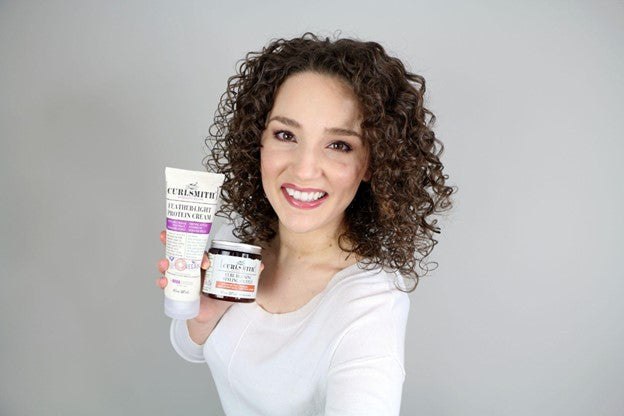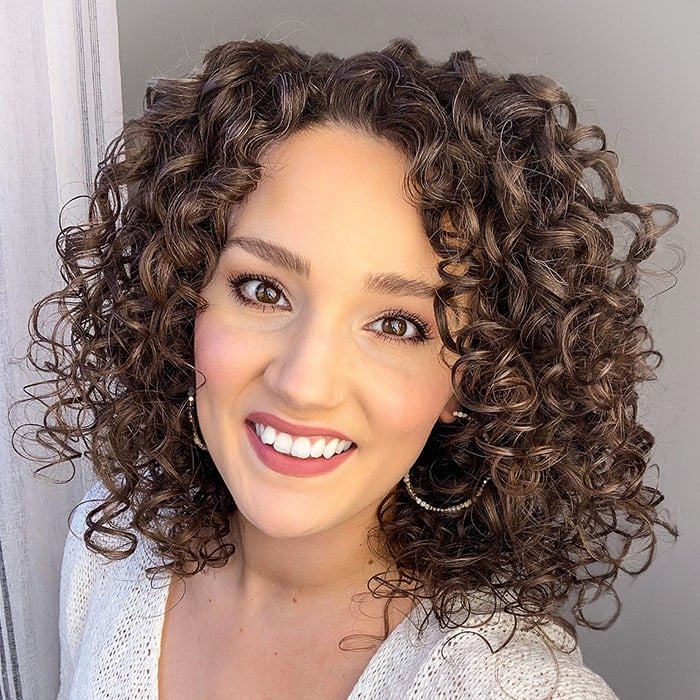Protein or Moisture? Learn What Your Curls Need

Does my hair need protein or moisture? This is the question we all find ourselves deliberating on when we’re facing an issue with our curls, or when we’re going to pick out products. However, our curls need both, and it’s often not an issue of needing one or the other. There are occasions when you may need to use more of one or the other, and certain hair types can benefit from a bit more protein or moisture in their routine compared to others.
What do protein and moisture mean for curls?
How to tell if your curls need protein or moisture
How to tell if your hair needs protein
How to tell if your curls need more moisture
Best protein-rich hair products
Best moisturizing hair products
Maintaining a balance of protein and moisture
Simple hair care with Curlsmith
What do protein and moisture mean for curls?
Protein
Our hair is made of up proteins, specifically keratin. Protein ingredients are added to curly hair products to help strengthen the hair and prevent breakage. One lesser-known fact about proteins is they also help our hair retain moisture by creating a protective film on the hair, temporarily filling in the gaps in our cuticle, the outermost protective layer of our hair that easily becomes damaged.
Protein ingredients are easy to spot on a product’s label because they commonly include the word “protein.” Sometimes proteins will also show up as collagen or keratin. Examples of common protein ingredients include:
- Hydrolyzed wheat protein
- Hydrolyzed silk protein
- Hydrolyzed quinoa protein
- Hydrolyzed soy protein
- Hydrolyzed oat protein
Moisture
Moisture is a much broader term when used in haircare, but scientifically, it means water. Most hair products already contain water as the first ingredient. Humectants are a type of ingredient also found in hydrating hair products that helps the hair attract water and retain it.
The most commonly used humectants include:
- Glycerin
- Hyaluronic acid
- Panthenol
- Aloe
- Flaxseed
However, when people say they want to moisturize their hair, they are usually referring to the effects of “conditioning” the hair which is increasing softness, shine, and manageability. Conditioning your hair is key for maintaining the health of our hair, especially curly hair that is naturally more dry compared to straight hair due to its lack of sebum and the ability for it to travel down the hair strands.
Emollients are ingredients that condition the hair and can commonly be in the form of plant oils and butters such as:
- Coconut oil
- Shea butter
- Jojoba seed oil
- Argan oil
Emollient ingredients work to lock moisture in the hair, provide softness, and help to promote shiny hair.
Both protein and moisturizing ingredients are conditioning for the hair. Most curly hair products contain moisturizing ingredients, even those that contain proteins. Some products will just contain a high amount of protein ingredients, in addition to moisturizing ingredients, while others will be protein-free and just have moisturizing ingredients.
How to tell if your curls need protein or moisture
While most people with curly hair will need a protein and moisture balance, some may need more than others. There are two things you need to understand about your curls in order to determine how much protein and moisture you need.
- Porosity: How easily your hair absorbs water and products, or its damage level. Porosity is a scale, but to simplify it, porosity ranges from low to medium, to high.
- Texture: The thickness of your individual strands. Texture ranges from fine to medium, to coarse.
How to tell if your hair needs protein

The finer your hair is, the more protein you can use to prevent breakage and add structure. Those with fine, high-porosity hair will need the most protein, and those with coarse low-porosity hair will need the least amount of protein. Also, the more high-porosity your hair is, the more protein it will need to help fill in the cracks in the cuticle. If you have highlighted hair you will also need to use protein regularly.
Protein is ideal for those who have signs of damaged hair from:
- Bleach
- Chemical services
- Hair dye
- Heat tools
- Detangling
Medium-textured or medium-porosity hair can also incorporate protein as needed. Many people with healthy hair or medium hair still use heat through diffusing, are exposed to damaging UV rays, and may experience damage from detangling.
Signs of not enough protein
- Split ends or breakage
- Limp curls that are not forming into their usual shape
- Lack of definition
- Curls don’t hold up after wash day
How to tell if your curls need more moisture
Everyone with curly hair can benefit from moisture, but some may need extra moisture incorporated into their curly hair routine. The coarser your hair texture is, the more moisture you’ll need to help soften and condition the hair. Those with coarse, high-porosity hair will need the most moisture, and those with fine low-porosity hair will need the least moisture.
If you live in a dry climate, you may also find that you need to incorporate more moisturizing ingredients to help your hair retain moisture. Other environmental factors such as the sun’s UV rays can contribute to dryness, so incorporating moisture after sun exposure is important.
Signs of not enough moisture
- Dullness & lack of shine
- Brittle feeling
- Curls won’t clump
- Split ends or breakage
- Flyaways and frizz
Curlsmith also has a curl quiz that you can take to help determine your hair’s needs and it will suggest protein or more moisturizing products.
Best protein-rich hair products

Protein ingredients can be found in any curly hair care product, ranging from shampoos to styling gels. Curlsmith makes finding products with protein easy by shopping the Strength Recipe line of products.
For the strongest dose of protein, you can use a product like Curlsmith’s Bond Curl Rehab Salve. This pre-shampoo treatment can be used on any hair type but is especially beneficial for damaged hair. It contains bond-repairing ingredients that work to strengthen three types of bonds in the hair, including disulfide, hydrogen, and salt bonds. It also contains chia seed extract and creatine, which help the hair retain moisture. Always follow up with a shampoo and a deep conditioner to restore softness and condition the hair.
To incorporate more protein in your routine but at a lower dose, you can try a product such as the Curlsmith Multi-tasking Conditioner. This 3-in-1 product can be used as a regular rinse-out conditioner, leave-in conditioner, or a deep conditioner. It contains rice protein for strength and is balanced with conditioning ingredients such as castor seed oil, babassu oil, and murumuru butter.
In addition, there are several other products from the Strength Recipe, such as the Feather-Light Protein Cream and the Shape Up Aqua gel which are styling products that contain protein ingredients.
Best moisturizing hair products

Almost all products for curly hair contain moisturizing ingredients, but you will find that some are richer in moisture than others. Products from Curlsmith’s Moisture Recipe are packed with conditioning ingredients such as oils and butters. This recipe is suitable for all hair types, but is especially beneficial for those with extra dry hair. The Scalp Recipe is also highly moisturizing but is more lightweight so it won’t weigh down the hair.
If your hair is very dry and brittle, one of the best ways to get a high dose of moisture is to use a deep conditioner such as the Double Cream Deep Quencher. It contains nourishing sunflower oil, apricot kernel oil, avocado oil, and shea butter. These are emollient ingredients that will soften, add shine, and help the hair retain moisture.
For a lightweight deep conditioner, opt for the Hydro Creme Soothing Mask. This contains hyaluronic acid which is known for its moisture-retention properties. Depending on how dry your hair is, you can deep condition it 1-4 times per month.
Another way to incorporate more moisture is by using a leave-in conditioner and/or a curl cream underneath your styling product. For coarse and brittle hair, use a leave-in such as the Curl Conditioning Oil-in-Cream. Top it off with a styling gel like the Curl Defining Styling Souffle or In-Shower Style Fixer for strong hold.
For a lightweight leave-in, opt for the Weightless Air Dry Cream. This also contains moisturizing hyaluronic acid, castor oil, jojoba oil, and shea butter. It pairs well under the Hydro Style Flexi Jelly or the Fragrance-Free Shine Jelly.
Maintaining a balance of protein and moisture
As we’ve discussed, both protein and moisturizing ingredients are inherently “conditioning.” All curly hair types need conditioning, but there can be too much of a good thing. If you use too much protein or moisture when not needed, your hair can react negatively.
Protein overload
If you have healthy hair that is not damaged, you don’t want to go overboard with protein treatments or have protein in every single product of your routine since it’s not needed. Using too much protein can cause a stiff, brittle feeling because the proteins accumulate on the hair, known as protein overload. Those with coarse-textured hair are also known to experience brittleness from protein because this hair texture can naturally feel stiffer. This can cause the hair to lose its elasticity, and can even lead to breakage. Clarifying your curly hair with the Wash & Scrub Detox Shampoo and using highly moisturizing products afterward will correct this.
Moisture overload
On the other hand, it’s possible to over-moisturize your hair resulting in moisture overload. Those with fine-textured hair may be more likely to experience this because fine hair can get weighed down easily with emollient ingredients like oils and butters. Hair that is over-moisturized will feel overly soft, damp, and sometimes even mushy feeling. It can become overly elastic and not retain its shape, appearing limp.
To avoid over-moisturizing the hair, opt for more lightweight products and ensure you’re properly cleansing and clarifying regularly. Simply adding in protein will not fix over-moisturized hair as these types of ingredients are not opposites. With both protein overload and moisture overload, you need to remove the buildup and reduce the use of those particular ingredients afterward.
Simple hair care with Curlsmith
Understanding protein and moisture does not have to be complicated. Curly hair needs to be conditioned with both types of ingredients. The important thing to remember is to not go overboard with one or the other. Assess your hair’s needs based on the symptoms discussed here to determine if your hair needs more protein or moisture on any given wash day. Curlsmith’s various recipes take the guesswork out of shopping for products based on your needs. All Curlsmith’s products are cruelty-free, vegan, and free of sulfates, silicones, and parabens. Take the curl quiz to find the right products for your unique curl type.









